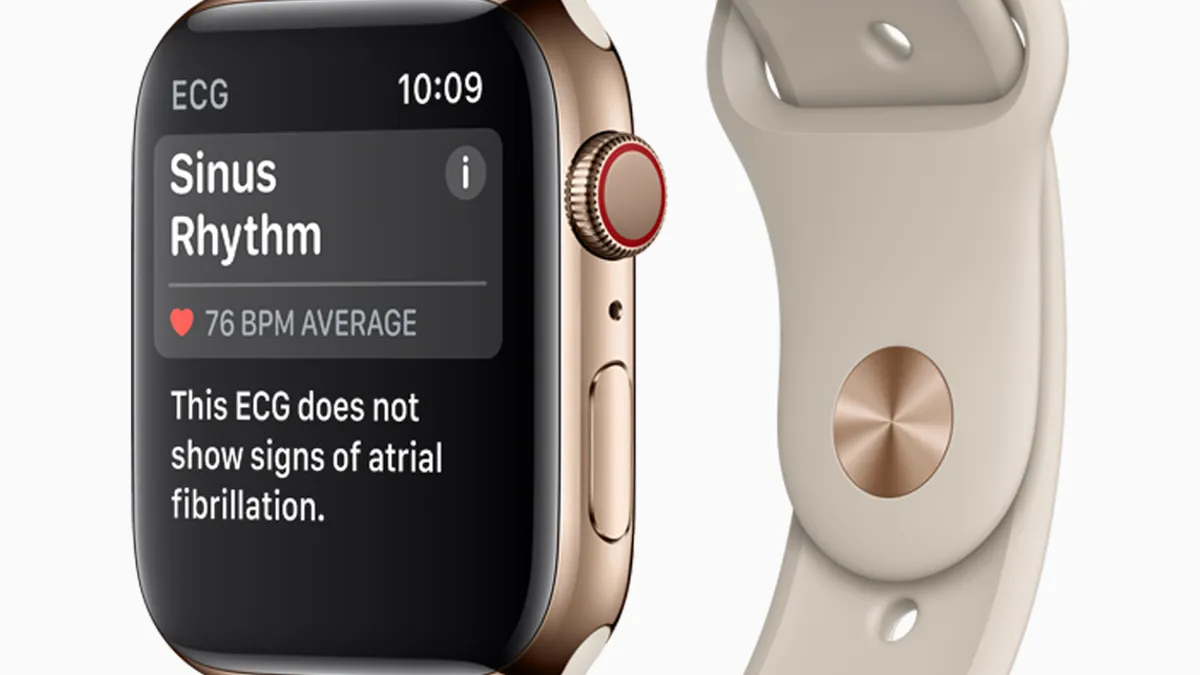Dive Brief:
- In a small study covered in JAMA Cardiology on Monday, a commercially available Apple Watch detected ST-segment changes similar to those recorded with a standard 12-lead electrocardiogram in patients with acute coronary syndrome, suggesting smartwatch technology could be useful for obtaining earlier diagnoses to prevent fatal events.
- The 100-patient feasibility study found the smartwatch and standard EKG were comparable in identifying normal EKG and certain elevation changes. The watch was placed in different body positions to get nine bipolar EKG tracings that were compared with a simultaneous multiple-lead EKG.
- The COVID-19 pandemic has triggered a massive expansion of telehealth for cardiology care, and the smartwatch study suggests that similarly, an easy-to-use, home-based EKG could aid in assessing a patient's initial chest pain away from a healthcare setting, leading to faster response times, Mintu Turakhia of Stanford University School of Medicine's Center for Digital Health, wrote in an editor's note accompanying the article.
Dive Insight:
Apple has generated some data that its smartwatch can help detect atrial fibrillation, per a study last year involving 419,000 people, and found a low likelihood of patients receiving an irregular pulse notification. Among its rivals, Verily has received 510(k) clearance for the EKG feature of its watch, and Fitbit is also studying use of its devices in detecting arrhythmias.
Use of wearables in heart disease detection has elicited concerns about accuracy from medical groups. Still, a consortium of heart rhythm bodies including the Heart Rhythm Society said this year the overall evidence is favorable toward their use when integrated into clinical care.
Authors of the Apple Watch study shared at the European Society of Cardiology Congress this week pointed out in a JAMA Cardiology article that an electrocardiogram is not always available to immediately help people with suspected acute coronary syndrome, a term that describes a range of conditions associated with sudden reduced blood flow to the heart.
Smartwatches, on the other hand, are widespread, they argue, and are increasingly being used for digital health purposes. Acute coronary syndromes are the leading cause of death worldwide, and quick diagnosis is essential to improve patients' chances for survival.
The study authors, affiliated with Italy's Magna Graecia University, said they believe theirs is the first study to assess the use of a smartwatch in patients with acute coronary syndromes. While wearables are not designed for clinical settings such as rapid triage, emergency department, ambulance or field work, they said, a smartwatch could be used to recognize ST-segment changes in individuals with chest pain when a standard EKG is not available, including during a pandemic or catastrophe.
Turakhia of Stanford, a principal investigator of the Apple Heart Study, said EKGs could hold promise as part of a home-based diagnostic kit for rhythm or QT interval monitoring for some patients. A home-based EKG with high negative predictive value for ischemia could facilitate a telehealth assessment of a patient's initial chest pain, Turakhia wrote.
Researchers at the University of California, San Francisco, also have looked at heart rate data generated using a smart device, concluding in a study published in Nature's digital health journal that data from 50 patients using an EKG and smart device at the same time showed a strong correlation between readings captured on the two types of devices.








